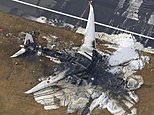
The smoke hadn’t cleared from the crash site of a Japan Airlines Airbus A350 in Tokyo earlier this month, yet video footage from the incident had already been uploaded to social media, causing shock and amazement in the aviation world.
But what surprised airline professionals wasn’t the emergency, particularly, but the reaction to the potentially deadly situation on January 2 that all 367 passengers and 12 crew members survived.
On my Fly Guy’s Cabin Crew Lounge on Facebook and Instagram, thousands from the world’s largest global community of airline crew were commenting in astonishment on the calm behaviour of the passengers as they sat in a plane that was on fire.
I annotated footage from the crash to highlight how following the examples of the passengers on JAL flight 516 could save others in future aviation disasters. This video has now been viewed more than 10million times.
Here I expand upon this clip, explaining in more detail the main lessons from this masterclass example of how to survive a plane crash. Plus there’s an additional tip from me, A Fly Guy, an aviation specialist with more than 20 years of commercial airline experience, including working as a cabin crew manager for Emirates on the world’s largest passenger aircraft seating up the 615 passengers.
Remain calm and don’t panic
The main thing that shocked airline professionals was how calm passengers were in the videos captured inside the cabin after the widebody Airbus hit a smaller turboprop aircraft.
The void of panic created the ideal scenario for the flight attendants to focus entirely on the situation without worrying about crowd control.
In those moments, the crew’s main goal was to properly assess the conditions outside their doors to determine if they would use their exit or direct passengers to another station.
Cabin crews undergo extensive training on handling this very situation and what threats to check for – procedures based on data collected from aviation emergencies over the past century.
Approaching their doors and adding intense pressure while they’re following their training could cause the use of a dangerous exit and lead to unnecessary injuries.
Former Emirates flight attendant Jay Robert reveals how the passengers of Japan Airlines flight 516 gave a masterclass in how to survive a plane crash. He writes: ‘The void of panic created the ideal scenario for the flight attendants to focus entirely on the situation without worrying about crowd control’
Passengers from the JAL incident at Haneda Airport recounted the crew took a few minutes before they opened the doors, a common practice of airline emergency safety procedures.
There are a few reasons evacuations could be delayed if there is a fire outside the aircraft, but the main reason is that the crew usually waits on the command from the pilots, who are busy following their procedures to prepare the plane for an evacuation.
During this critical period, one of their main tasks is to turn off the engines to assist with slide usage and stop people from getting ingested.
In 2015, British Airways pilots skipped this step before initiating the evacuation of a Boeing 777, which caught fire on the runway in Las Vegas. As reported in AV Herald, the oversight resulted in an engine blast that rendered all but two of the eight slides unusable.
Leave everything!
Taking belongings is a deadly mistake that has killed passengers and crew during evacuations. Not only does it slow the entire evacuation process down, but a suitcase could damage the slide, causing the loss of a valuable exit. In the Japan Airlines passenger videos, they keep bins closed and leave their bags behind.
That aircraft only had three of the eight doors available for evacuation, and the passengers could move quickly to those doors and down the slides because they had their hands free and weren’t tripping over their luggage.
If the cabin is full of smoke, like on flight 516, you could be forced to get down and crawl towards survival, and your belongings would not make that easy.
Stay at the bottom of the slides and help others off
Assistance for passengers coming down the slide is ‘crucial’, says Jay
Evacuations require teamwork.
Flight attendants and pilots are trained to remain inside the aircraft until all passengers are out, which means passengers are needed to help at ground level.
At the bottom of the emergency slides of the JAL aircraft, you could see crash victims in the footage assisting fellow passengers to catch their feet at the bottom of the slide.
This assistance is crucial as many injuries during aircraft evacuation come from using the slides.
In addition, weather conditions can impact the use of the slides. For example, in 2016, an Emirates Boeing 777 crashed during landing in Dubai. Many of the exits were unusable.
High winds were a factor in blocking some of the doors as the slides were blowing off the ground.
Passengers can assist by holding the slides down to stabilise them for use. In addition, slides can deflate, and if this happens, passengers need to pick up the bottom of the deflated slide and hold the slide straight and away from the aircraft to create what is called an apron slide.
Run away from the plane
This aerial photo shows the burned-out remains of Japan Airlines flight 516
Two common mistakes occur during evacuations: bags and social media influencing when passengers should be running to safety.
We are aware many passengers are taking bags because so many other passengers are taking photos and videos as soon as they get down the slide next to what could be ticking time bombs.
Once your feet hit the ground, follow the example of the passenger of the JAL flight – run to a safe distance, and congregate with others.
From that distance, take all the photos you need to show your followers you know how to survive safely.
During the Emirates incident, one firefighter standing near the crashed aircraft lost his life after a fuel tank exploded just minutes after the crew and passengers got to a safe distance.
Prepare for the worst
Jay (above) runs the popular Fly Guy’s Cabin Crew Lounge network
Each flight I take, I hope for the best and prepare for the worst. It might sound morbid to think of your plane crashing every time you fly, considering it’s one of the safest forms of transport, but still preparing your mind and surrounding area can increase your chances of safely escaping if you face the worst-case scenario.
You probably don’t even realise you have taken this step already.
I mentally review my nearest exit and how many rows there are to the door because, in an emergency, smoke often reduces visibility
Jay Robert, former flight attendant
Every time you take off and land, your flight attendants prepare you and the cabin for a potential crash or emergency.
They’re putting seatback and tray tables upright and ensuring bags are under seats or bins to ensure you have the fastest exit possible.
When I fly, I keep a small cross-body bag attached to myself containing my phone, passport, wallet, and essential items.
If I need to get out in a hurry, I have my basics and no connection to the bags I will leave behind. Note, on some airlines, you must stow the small body bag if seated in an exit row, even if it’s attached to your body.
I also ensure that items that could become a tripping hazard, such as rubbish, blankets, and charging cables, are put away.
Most importantly, I mentally review my nearest exit and how many rows there are to the door because, in an emergency, smoke often reduces visibility.
I review the safety card to identify all exits as the one next to me might not be usable like in the three crashes mentioned previously.
Your cabin crew, too, are doing a mental emergency review on landing, so you shouldn’t distract them while they’re sitting on their jumpseats once the captain informs them to prepare for landing.
I always felt terrible when facing passengers in my crew seat.
I had to ignore them because it was against protocol to talk during that critical stage of the flight.
For more from Jay visit www.instagram.com/aflyguytravels and www.facebook.com/aflyguyslounge.
Source link
CHECK OUT: Top Travel Destinations
READ MORE: Travel News



